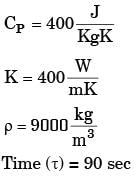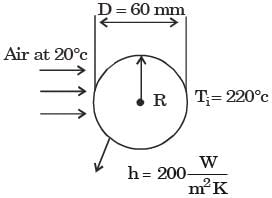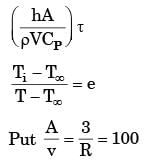Q1: Consider a rod of uniform thermal conductivity whose one end (x = 0) is insulated and the other end (x = L) is exposed to flow of air at temperature T∞ with convective heat transfer coefficient h h. The cylindrical surface of the rod is insulated so that the heat transfer is strictly along the axis of the rod. The rate of internal heat generation per unit volume inside the rod is given as
 = cos 2 π x /L
= cos 2 π x /L
The steady state temperature at the mid-location of the rod is given as TA . What will be the temperature at the same location, if the convective heat transfer coefficient increases to 2h ? [GATE ME 2022, SET-1]
(a) TA +  L/2h
L/2h
(b) 2TA
(c) TA
(d) 
Ans: (c)

 = cos 2 π x /L
= cos 2 π x /L
Total heat generation = Q g =  (Volume)
(Volume)

Q g = 0
At steady state Q stored = 0
Q in + Q gen - Q out = Q stored
Q gen = Q out
0 = h As (Ts - T∞
h and AS can't be zero it means TS = T∞
It indicate that Ts is independent of heat transfer coefficient.
So it means temperature of body any where is independent of heat transfer coefficient.
So by increasing heat transfer coefficient there is no change in the temperature at mid location.
Q1: An uninsulated cylindrical wire of radius 1.0 mm produces electric heating at the rate of 5.0 W/m. The temperature of the surface of the wire is 75°C when placed in air at 25°C. When the wire is coated with PVC of thickness 1.0 mm, the temperature of the surface of the wire reduces to 55°C. Assume that the heat generation rate from the wire and the convective heat transfer coefficient are same for both uninsulated wire and the coated wire. The thermal conductivity of PVC is ______W/m.K (round off to two decimal places). [GATE ME 2021, SET-1]
Ans: (0.1 to 0.12)
For uninsulated wire:
Given: T∞ = 25°C , R1 = 1 mm ,  gen = 5 W/m , T s1 = 7. 5°C
gen = 5 W/m , T s1 = 7. 5°C


5 x L = h x (2π x 0.001) L x (75 - 25)
h = 15.91 W/m2 K
For Insulated wire:
 R2 = 2 mm
R2 = 2 mm
Heat transfer rate after insulation kept on wire,
q = q gen, wire x L = 5 x L
 k PVC =0.1103 W/m - K
k PVC =0.1103 W/m - K
= 0.11 W/m -K
Q2: An infinitely long pin fin, attached to an isothermal hot surface, transfers heat at a steady rate of Q1 to the ambient air. If the thermal conductivity of the fin material is doubled, while keeping everything else constant, the rate of steady- state heat transfer from the fin becomes Q2. The ratio Q2/ Q1 is [GATE ME 2021, SET-1]
(a) √2
(b) 2
(c) 1/√2
(d) 1/2
Ans: (a)
Fin problem:

q =  (TO - T∞) wait
(TO - T∞) wait
If k gets doubled q increases by √2 times.
Question for GATE Past Year Questions: Fins & Unsteady Heat Transfer (Conduction & Convection)
Try yourself:Two rods, one of length L and the other of length 2L are made of the same material and have the same diameter. The two ends of the longer rod are maintained at 100°C. One end of the shorter rod is maintained at 100°C while the other end is insulated. Both the rods are exposed to the same environment at 40°C. The temp at the insulated end of the shorter rod is measured to be 55°C. The temperature at the mid point of the longer rod would be.
[1992]
Question for GATE Past Year Questions: Fins & Unsteady Heat Transfer (Conduction & Convection)
Try yourself:A fin has 5 mm diameter and 100 mm length. The thermal conductivity of fin material is 400 Wm–1K–1. One end of the fin is maintained at 130°C and its remaining surface is exposed to ambient air at 30°C. If the convective heat transfer coefficient is 40 Wm–2K–1, the heat loss (in W) from the fin is
[2010]
Explanation
Report a problem
Question for GATE Past Year Questions: Fins & Unsteady Heat Transfer (Conduction & Convection)
Try yourself:Which one of the following configurations has the highest fin effectiveness?
[2012]
Question for GATE Past Year Questions: Fins & Unsteady Heat Transfer (Conduction & Convection)
Try yourself:The heat transfer process between body and its ambient is governed by an Intemal Conductive Resistance (ICR) and an External Convective Resistance (ECR). The body can be considered to be a lumped heat capacity system is
[1989]
Explanation
Lumped heat capacity can be applied when Bi < 0.1
 for desired condition i.e. Bi < 0
for desired condition i.e. Bi < 0
k > h, ICR is small
Report a problem
Question for GATE Past Year Questions: Fins & Unsteady Heat Transfer (Conduction & Convection)
Try yourself:Biot number signifies
[1991]
Explanation
Biot number 
Report a problem
Question for GATE Past Year Questions: Fins & Unsteady Heat Transfer (Conduction & Convection)
Try yourself:Lumped heat transfer analysis of a solid object suddenly exposed to a fluid medium at a different temp is valid when
[2001]
Explanation
For lumed system analysis,
Bi < 0.1
Report a problem
Question for GATE Past Year Questions: Fins & Unsteady Heat Transfer (Conduction & Convection)
Try yourself:The value of Biot number is very small (less than 0.01),when
[2002]
Explanation
When conductive resistance of solid is negligible, then biot number is very small.
Report a problem
Question for GATE Past Year Questions: Fins & Unsteady Heat Transfer (Conduction & Convection)
Try yourself:A spherical thermocouple junction of diameter 0.706 mm is to be used for the measurement of temperature of a gas stream. The convective heat transfer coefficient on bead surface is 400 W/m2K, Thermophysical properties of thermocouple material are k = 20 W/mK, c = 400 J/kgK and r = 8500 kg/m3. If the thermocouple initially at 30°C is placed in a hot stream of 300°C, the time taken by the bead to reach 298°C, is
[2004]
Explanation
Report a problem
Question for GATE Past Year Questions: Fins & Unsteady Heat Transfer (Conduction & Convection)
Try yourself:A small copper ball of 5 mm diameter at 500 K is dropped into an oil bath whose temperature is 300 K. The thermal conductivity of copper is 400 W/mK, its density 9000 kg/m3 and its specific heat 385 J/kgK. If the heat transfer coefficient is 250 W/m2K and lumped analysis is assumed to be valid, the rate of fall of the temperature of the ball at the beginning of cooling will be, in K/s,
[2005]
Explanation
Report a problem
Question for GATE Past Year Questions: Fins & Unsteady Heat Transfer (Conduction & Convection)
Try yourself:The average heat transfer coefficient on a thin hot vertical -plate suspended in still air can be determined from observations of the change in plate temperature with time as it cools. Assume the plate temperature to be uniform at any instant of time and radiation heat exchange with the surroundings negligible. The ambient temperature is 25°C, the plate has a total surface area of 0.1 m2 and a mass of 4 kg. The specific heat of the plate material is 2.5 kJ/kgK. The convective heat transfer coefficient in W/m2K, at the instant when the plate temperature is 225°C and the change in plate temperature with time dT/dt = – 0.02 K/s, is
[2007]
Explanation
From heat balance equation,

where, T0 = Ambient temperature
∴ 
Report a problem
Question for GATE Past Year Questions: Fins & Unsteady Heat Transfer (Conduction & Convection)
Try yourself:Consider steady-state heat conduction across the thickness in a plane composite wall (as shown in the figure) exposed to convection conditions on both sides. Given: hi = 20 W/m2K; h0 = 50 W/m2K; T∝i = 20°C; T∝,0 = -2°C; k1 = 20 W/mK; k2 = 50 W/mK; L1 = 0.30 m and L2 = 0.15 m. Assuming negligible contact resistance between the wall surfaces, the interface termperature, T(in °C), of the two walls will be

[2009]
Explanation
Report a problem
Question for GATE Past Year Questions: Fins & Unsteady Heat Transfer (Conduction & Convection)
Try yourself:A spherical steel ball of 12 mm diameter is initially at 1000 K. It is slowly cooled in a surrounding of 300 K. The heat transfer coefficient between the steel ball and the surroundings is 5 W/m2K. The thermal conductivity of steel is 20 W/mK. The ternperature difference between the centre and the surface of the steel ball is
[2011]
Explanation

For the given condition, Biot number tends to zero, i.e. conduction resistance is far less than convection resistance. Therefore temperature between centre and surface is very small.
Report a problem
Question for GATE Past Year Questions: Fins & Unsteady Heat Transfer (Conduction & Convection)
Try yourself:A steel ball of diameter 60 mm is initially in thermal equilibrium at 1030°C in a furnace. It is suddenly removed from the furnace and cooled in ambient air at 30°C, with convective heat transfer coefficient h = 20 W/m2K. The thermophysical properties of steel are : density ρ = 7800 kg/m2, conductivity k =40 W/mK and specific heat c - 600 J/kgK. The time required in seconds to cool the steel ball in air from 1030°C to 430°C is
[2013]
Explanation
Report a problem
Question for GATE Past Year Questions: Fins & Unsteady Heat Transfer (Conduction & Convection)
Try yourself:Biot number signifies the ratio of
[2014]
Explanation
Biot number provides a way to compare the conduction resistance within a solid body to the convection resistance external to the body (offered by the surrounding fluid) for heat transfer:

Where ‘s’ is a characteristic dimension of the solid
‘h’ is convective heat transfer coefficient
‘k’ is thermal conductivity of the body.
Report a problem
Question for GATE Past Year Questions: Fins & Unsteady Heat Transfer (Conduction & Convection)
Try yourself:A metal ball of diameter 60 mm is initially at 220°C. The ball is suddenly cooled by an air jet of 20°C. The heat transfer coefficient is 200 W/m2K. The specific heat, thermal conductivity and density of the metal ball are 400 J/kgK, 400 W/mK and 9000 kg/m3, respectively. The ball temperature (in °C) after 90 seconds will be approximately
[2017]
Explanation
Report a problem
 = cos 2 π x /L
= cos 2 π x /L L/2h
L/2h

 = cos 2 π x /L
= cos 2 π x /L (Volume)
(Volume)
 gen = 5 W/m , T s1 = 7. 5°C
gen = 5 W/m , T s1 = 7. 5°C

 R2 = 2 mm
R2 = 2 mm k PVC =0.1103 W/m - K
k PVC =0.1103 W/m - K
 (TO - T∞) wait
(TO - T∞) wait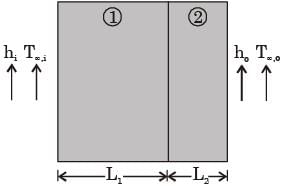









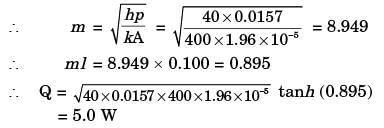
 for desired condition i.e. Bi < 0
for desired condition i.e. Bi < 0
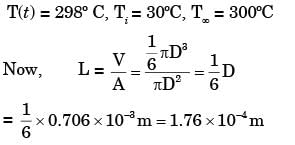

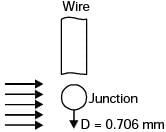
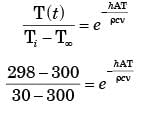
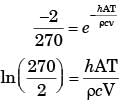
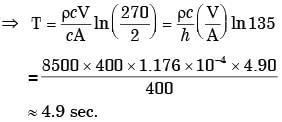

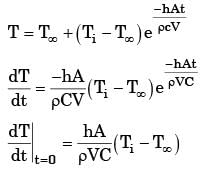













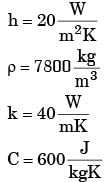
 ...(i)
...(i) 


